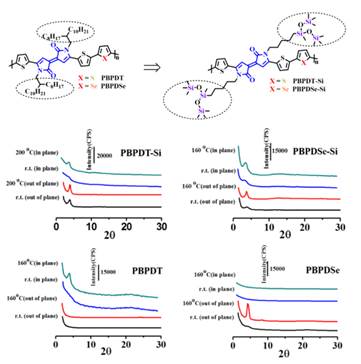| Conjugated Donor-Acceptor Polymers Entailing Pechmann Dye-Derived Acceptor with Siloxane-Terminated Side Chains Exhibiting |
| From: PublishDate:2017-06-16 Hits: |
For the development of new optoelectronic materials, alternating conjugated electron donor-acceptor (D-A) polymers have been intensively studied in recent years. Normally, the molecular design strategy is to devise new electron-rich and -deficient frameworks. Zhang et al. (Institute of Chemistry, Chinese Academy of Sciences) have recently disclosed a new bis-amide acceptor (BPD), and successfully utilized BPD to synthesize conjugated polymers. Being dependent on the electron donors, the resulting polymers show either p-type or ambipolar semiconducting properties. However, their electron mobilities are relatively lower than hole mobilities, and thus the hole and electron transporting is unbalanced. Recently, they report new exploration of BPD-based conjugated D-A polymers entailing thiophene and selenophene as the respective electron donors with siloxane-terminated side chains. The results reveal that the replacement of the branching alkyl chains with siloxane-terminated side chains is beneficial for improving the semiconducting performances of the BPD-based polymers. They exhibit more balanced ambipolar semiconducting properties with electron and hole mobilities up to 0.87 and 0.74 cm2 V-1 s-1, respectively. Their research has been published on August 12, 2016 in Macromolecules (2016, 49, 5857-5865.). They have studied the packing mode of polymers on the thin films by using GIXRD from 1W1A, Beijing Synchrotron Radiation Facility. They find that the polymers with siloxane-terminated side chains exhibit both face-on and edge-on intermolecular arrangements, while the polymers with normal alkyl chains only exhibit edge-on or face-on arrangement. This may be the main reason of more balanced semiconducting behaviors of siloxane-terminated side chain containing conjugated polymers. This study demonstrates that side-chain engineering is a beneficial way to improve the performance of organic semiconductors. http://pubs.acs.org/doi/abs/10.1021/acs.macromol.6b01440
Article: Sifen Yang, Zitong Liu*, Zhengxu Cai, Hewei Luo, Penglin Qi, Guanxin Zhang, Deqing Zhang*, Conjugated Donor–Acceptor Polymers Entailing Pechmann Dye-Derived Acceptor with Siloxane-Terminated Side Chains Exhibiting Balanced Ambipolar Semiconducting Behavior. Macromolecules, 2016, 49, 16, 5857-5865. |
|
|
| Chinese
- Metal-free efficient photocatalyst for stable visible water splitting——Top ten major scientific progresses in China in 2015
- The nano-resolution imaging platform was awarded the first rate prize of Beijing Science and Technology in 2014
- Beamline 1W1 of BSRF started to runoperate in the couplingparasitic mode of BEPCII
- Synthesis of High Performance Polymer Materials for Field Effect-Transistors
- Surfactant molecular aggregates in green solvents
- GIXRD has played an important role in the characterization of organic thin-film transistors
Science Highlights
Home /
Copyright © 2011 - 2012 Beijing Synchrotron Radiation Facility


